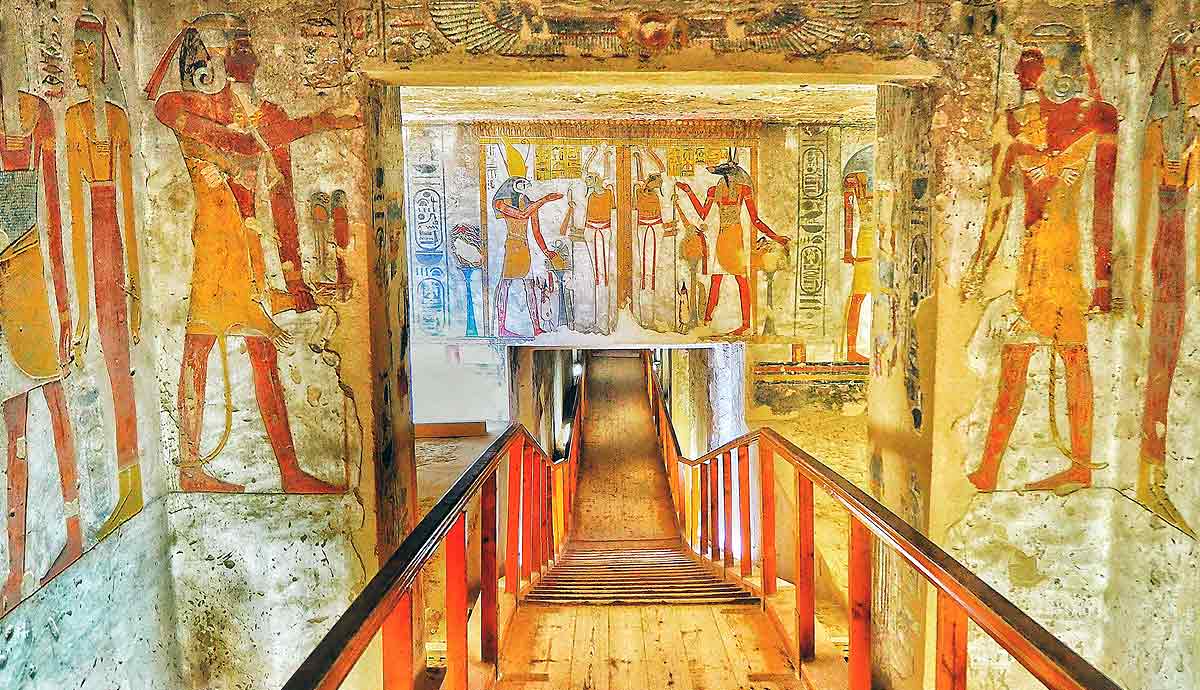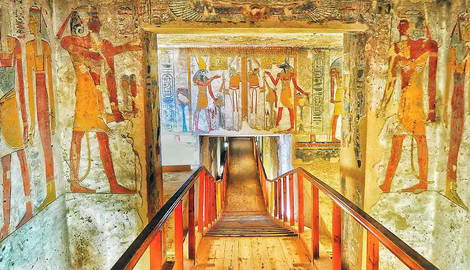
Archaeologists, looters, and tourists have turned some of the world’s most sacred funerary locations into open areas for visitors. The Valley of the Kings in Egypt is one of the most popular such attractions, hosting over a million people each year.
Perhaps the most legendary home of after-death lore and mythology, Egypt is home to mystery, drama, and supernatural traditions unlike any other place. The Valley of the Kings, host to dozens of tombs, is particularly appealing to those intrigued by ancient enigmas.
Resting Place of Royals

The Valley of the Kings is located across the Nile from the city of Luxor (once Thebes), formerly the royal capital of the Egyptian kingdom. The complex lies in the desert hills on the west bank of the river, surrounded by steep cliffs of limestone bedrock.
There are 64 tombs located throughout the valley, ranging in size and scale. Some are simple pit tombs, while others are ornate burial chambers with labyrinths of numerous rooms. The valley was the principal burial site for rulers of Egypt’s New Kingdom, which lasted from approximately 1550 to 1077 BCE. In addition to the pharaohs themselves, these ruler’s wives, relatives, and pets are buried in the valley. Some of the tombs remain unidentified.

Approximately 1.5 million tourists from around the world visit the Valley of the Kings each year. While not all of the tombs are stable and open to the public, visitors do have the opportunity to walk among the ornate lives of these former rulers and imagine what life was like in ancient Egypt. Whose tombs are among them?
Ramses II

Ramses II was the pharaoh of Egypt during its “golden age.” With an almost 67-year reign, he was one of Egypt’s longest-ruling monarchs. His tomb in the Valley of the Kings echoes his history of greatness, boasting one of the largest constructions with numerous chambers. However, Ramses II’s mummified body actually spent very little time there, as it was relocated by ancient priests due to looting. It was moved to another tomb, and then later unearthed by archaeologists. Today the body resides in Cairo’s Egyptian Museum.

Born a commoner, Ramses was named after his grandfather Ramses I, who moved the family up the social ladder with his military skills. Ramses II’s father, Seti, would become pharaoh when his son was five years old. Ramses would become pharaoh himself at 25, with his beloved wife Nefertari at his side. In addition to Nefertari, Ramses II had numerous other women in his life and he is ranked 10th on the list of men with the most children in history, believed to have fathered over 160.

Ramses II’s accomplishments included military victories, a number of construction and renovation projects, and the use of propaganda to his benefit. He is believed by some to be the pharaoh mentioned in the biblical story of the Exodus and he is remembered on countless monuments, both of his own construction and others.
Seti I

Ramses II’s father, Seti I, has his own enviable tomb in the Valley of the Kings. It is a long, descending tomb with several beautifully decorated rooms. The lower burial chamber is decorated with representations of the constellations and the night sky. Ancient funerary texts embellish the tomb throughout, aimed at ensuring Seti’s successful movement into the afterlife. Unlike Ramses II’s tomb, which has suffered flooding numerous times, Seti’s tomb remains exquisitely intact, with paintings and reliefs along the corridors and rooms. It is believed to be one of the first tombs to be so ornately decorated, and it is the first to feature a vaulted ceiling.

Seti’s name means “of Seth,” referring to the god Seth, who ruled over chaos, storms, violence, and disorder. However, Seti’s reign was relatively successful, and filled with considerable achievements. He fought many battles, including against the powerful Hittite army. Infrastructure grew under Seti I, with the establishment of quarries, wells, and the renovation of many shrines and temples.
Queen Nefertari

Although she was said to be of noble blood, Nefertari’s family origins are unknown. She was an educated woman and possessed a rare skill for the time: The ability to read and write hieroglyphs. She was involved in diplomatic efforts and was clearly important to her husband, the pharaoh Ramses II.
Although Ramses II had numerous wives and lovers, Nefertari was said to be his favorite. He honored her by building her an exquisitely decorated tomb and also a temple at Abu Simbel. The tomb is one of the larger ones in the Valley of the Kings, at 520 square meters (approx. 5,600 square feet). Her burial place was robbed at some point in antiquity, and the treasure that was bound in the tomb, along with the majority of Nefertari’s remains, was stolen.
The tomb was rediscovered by archaeologists in 1904 and by the late 20th century, it was deteriorating. In 1986, a restoration project began to return the wall paintings and hieroglyphic messages within Nefertari’s tomb to their original brilliance. The project lasted six years and was considered a success. The tomb was opened to the public in 1995, but the number of visitors is strictly monitored to control the number of bacteria introduced to the tomb and to curb the introduction of carbon dioxide and humidity. These measures will ensure that the restoration was not in vain and that Nefertari’s tomb remains intact for centuries to come.
Amenhotep II (and Friends)

Originally designed to hold and honor the Pharaoh Amenhotep II (sometimes spelled Amenhetep or Amenhotpe), the tomb designated “KV35” in the Valley of the Kings ended up as an after-death gathering place of sorts. Later royal mummies were stored in Amenhotep’s tomb in order to protect them from grave robbers who were seeking newly sealed graves. Ten mummies in addition to those of Amenhotep II, his son, and his mother were found when the tomb was opened in 1898 by explorer Victor Loret.

This burial place is 91 meters long (299 feet) and is one of the deepest chambers in the Valley. It includes a deep pit near the entrance designed to protect from flooding. The burial chamber is quite large and features a star-painted ceiling and inscriptions from the Egyptian Book of the Dead on the walls.

Amenhotep II ruled Egypt for about 26 years before he passed away around 1400 BCE. He was the 7th pharaoh of the 18th dynasty of the country. Occasionally he is referred to by the Greek variant of his name, Amenophis, in historical writings. He may have shared the throne with his father, Thutmose III, who preceded him, for approximately two years. Amenhotep was known for his athleticism, particularly as a young man. One of his most impressive feats was said to be his ability to shoot arrows through a copper plate while driving a chariot, reins wrapped around his waist. As a youth he trained horses in his father’s stable and was a talented horseman.

Amenhotep’s cause of death was unknown, but he was likely 40-50 years old at the time. When his mummy was discovered, it was noted that the body was covered with small rounded lesions, but it is unknown if these were due to illness or some part of the embalming process.
Tutankhamun

Perhaps the most famous of Egypt’s pharaohs in the world today, King Tutankhamun, or “Tut” was relatively unremarkable in his own time. Discovered in 1922, to this day Tut’s tomb remains the most intact Egyptian tomb ever discovered, providing archaeologists, historians, and the public with a wealth of information about Egyptian funerary tradition and religious rites. After a century of examination, the tomb continues to provide fodder for continued study.

In addition to providing researchers and Egyptologists with a wealth of information, King Tut’s tomb, believed to be cursed, has been a boon to pop culture. Though sometimes bordering on appropriation, ancient Egypt-influenced trends started showing up in fashion within months of the discovery of the tomb. Tut would be referenced in film and on television, and art deco themed designs including sphinxes and Egyptian columns would start popping up on buildings around the world. President Herbert Hoover even named his dog King Tut.

Tutankhamun ruled from 1332 to 1323 BCE, and ascended to the throne when he was eight or nine years old. In his short reign, he was guided by a number of advisers, particularly the Grand Vizier, Ay. His rule was relatively uneventful, though he was noted for overturning the religious reforms of his father, Akhenaten, and restoring Egypt to its polytheistic faith.
No one is quite sure how Tut died, though three theories seem to prevail based on the examination of his remains. Skull damage indicates that he may have suffered a blow to the back of the head, suggesting murder. However, this damage could have happened postmortem during the excavation process. He also had a broken kneecap that did not show signs of healing, meaning it happened close to the time of his death at age 18-19. As Tut was believed to be a charioteer, a chariot accident could be the cause. Malaria was also detected in his remains and could have contributed to his death.

Some who believe in the chariot theory feel their beliefs have been further proven by nighttime visitors to the Valley of the Kings, who have reported the presence of a ghostly pharaoh driving a chariot with fiery horses through the desert. It has been proposed that this is Tut’s ghost—unsettled and wandering for eternity.









